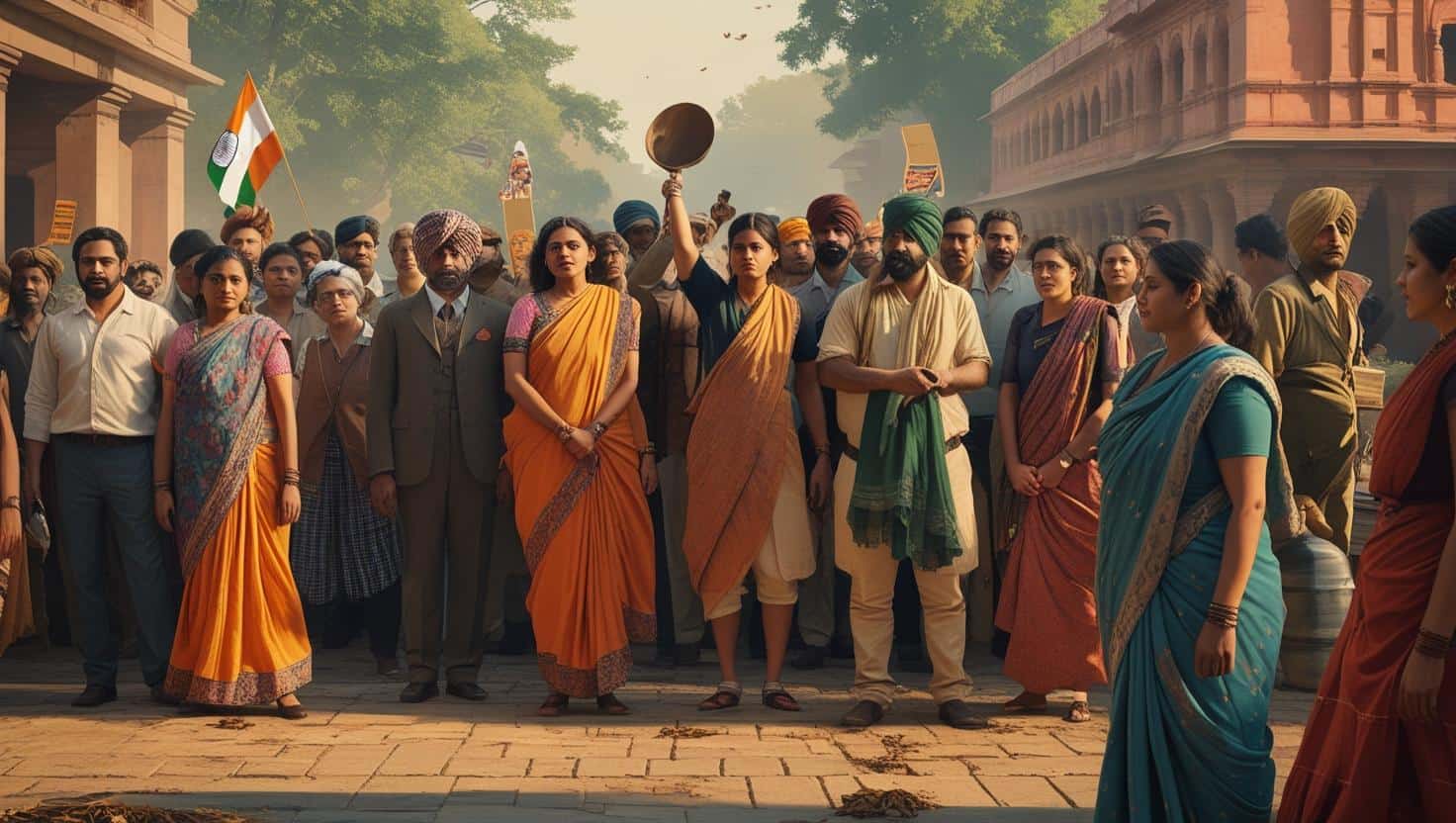We all know the giants—Gandhi’s Salt March seared into memory, Nehru’s stirring speeches, and Bhagat Singh’s heart-wrenching sacrifice. Their stories fill textbooks, as they should. But what if those towering figures stood on the shoulders of thousands? What if India’s freedom struggle wasn’t a single bonfire but countless sparks igniting across centuries?
Turns out, long before the 20th-century icons took center stage, ordinary people—warriors, farmers, tribal leaders, even queens—were already staring down the British Raj. These aren’t just footnotes; they’re raw, powerful chapters where courage flared in forgotten corners. Let’s uncover five of these hidden rebellions that reshaped India’s fight for swaraj:
1. Maharashtra’s Forgotten Guardians: The Ramosi Uprising (1822-1829)
Picture this: The Ramoshis, a community of trackers and guards who’d served the Marathas for generations, were suddenly stripped of their livelihoods when the East India Company rolled in. Their land? Taken. Their customs? Ignored. Harsh taxes pushed them to the edge.
Then came the spark. First, Chittur Singh in 1822, and then the legendary Umaji Naik, rallied them into guerrilla warriors. They weren’t just angry—they were strategic. Hitting British outposts, cutting communications, even raiding treasuries (and yes, sometimes sharing loot with the poor!). For nearly a decade, they turned the Pune-Satara region into a thorn in Britain’s side. Though crushed brutally by 1829 (Umaji executed in 1832), their rebellion was a deafening early warning: rural India wouldn’t swallow exploitation quietly. Today, Umaji’s still a folk hero in Maharashtra—proof that resistance ran deep, long before the “big names” arrived.
2. Odisha’s First War: The Paika Rebellion (1817)
Forty years before 1857’s “First War of Independence,” Odisha exploded. Meet the Paikas—Khuda’s fierce warrior-militia, protectors of the Gajapati kings. When the British took Odisha in 1803, they dismantled everything: seized Paika lands, slapped on brutal taxes, and even forced a hated new currency. It was an insult to their very identity.
Enter Bakshi Jagabandhu Bidyadhar, a respected Paika leader, left landless and furious. In 1817, he lit the fuse. Paikas stormed Khurda, attacked police stations, looted treasuries, and declared their government. For months, they held swathes of territory. The British were shaken to the core in the East. Though eventually crushed, Odisha never forgot. They call it their First War of Independence, and in 2017, India finally marked its 200th anniversary. Talk about a buried legacy!

3. Punjab’s Martyred Saints: The Kuka Revolt (1870s)
This one’s steeped in faith and fury. The Namdharis (or Kukas), a radical Sikh sect led by Baba Ram Singh, preached purity, equality, and outright rejection of British rule. They boycotted British goods, preached swadeshi, and saw colonial power as poison for Sikh traditions. Tensions simmered… until the British crossed a sacred line: slaughtering cows.
In 1872, the Kukas snapped. They attacked slaughterhouses in Malerkotla and even braved the British arsenal in Ludhiana. It was desperate, defiant, and doomed. The British response was pure horror. Deputy Commissioner L. Cowan ordered 65 captured Kukas blown apart by cannon, without trial. Sixteen more were hanged. Baba Ram Singh vanished into exile in Burma. Their sacrifice, though brutally erased, became a beacon. Their blend of religious fervor and non-cooperation? It planted seeds for movements that would later shake the empire.
📌 Please Read Also – Empire of the Stallion: Untold Power and Pride of the Maratha Kingdom
4. Jharkhand’s Earth-Shaker: Birsa Munda’s Ulgulan (1899-1900)
Imagine a young tribal visionary, barely 25, igniting a revolt that forced the Raj to change its laws. That’s Birsa Munda. His people, the Mundas, faced annihilation: British-backed landlords (dikus) stole their ancestral lands (khuntkatti), forcing them into bondage. Birsa fused tribal faith with liberation theology, declaring himself Bhagwan Birsa and calling for Munda Raj.
The Ulgulan (Great Tumult) erupted in 1899. Armed with bows, axes, and righteous fury, Mundas attacked police stations, symbols of oppression like missionary churches, and landlords’ properties. The British hit back with savage force. Birsa was captured and died mysteriously in jail in 1900. Hundreds perished. But their blood wasn’t spilled in vain. The rebellion forced the Chotanagpur Tenancy Act (1908), a landmark law protecting tribal land rights. Birsa, the boy-hero, remains an icon of indigenous resistance across India.

5. Karnataka’s Defiant Queen: Rani Chennamma of Kittur (1824)
Decades before Rani Lakshmibai, another queen roared, “Not my kingdom!” Rani Chennamma ruled Kittur. When her son died, the British invoked the hated “Doctrine of Lapse,” refusing her adopted heir, Shivalingappa, and demanding annexation. She refused. Bluntly.
War came in 1824. In a stunning first battle, her forces outmaneuvered the British, killing Collector St. John Thackeray (yes, that Thackeray’s uncle) and capturing soldiers. She offered peace for recognition. The British agreed to a truce… then betrayed her. A massive second assault took Kittur Fort. Chennamma died imprisoned in 1829. Her lieutenant, Sangolli Rayanna, waged guerrilla war until his capture and execution in 1831. She wasn’t just fighting for Kittur; she was a beacon against British greed, and Karnataka reveres her to this day.
Why Weren’t We Taught These Stories?
It’s not an accident. Colonial Britain painted these rebels as “bandits” or “fanatics,” burying their truths. Later, mainstream narratives sometimes sidelined them too. Why?
They were “local.” Peasant revolts, tribal uprisings—not the pan-Indian Congress movement.
They “failed.” Brutal suppression let history dismiss them as isolated blips, not connected struggles.
Different roots. Land rights, tribal identity, and faith, not always “India-first” ideology.
Deliberate erasure. Britain worked hard to scrub their legitimacy from the record.
Why Digging Them Up Matters Now
This isn’t just history nerding out. It’s vital:
Truth: Freedom wasn’t one river; it was countless streams. Resistance was everywhere, always.
Honor: Millions of faceless heroes—farmers, tribals, and local leaders—deserve their due. Their courage built the foundation.
Understanding: These fights expose the Raj’s real wounds: stolen land, broken cultures, and economic suffocation. Sounds familiar, right?
Inspiration: Queens, prophets, warriors… The sheer diversity of defiance is breathtaking.
Relevance: Tribal rights, land justice, resisting cultural wipeout? Their battles are still being fought.
Carrying the Hidden Flames
India’s freedom wasn’t won in a few iconic moments. It was forged in the daily defiance of people like the Ramosis guarding their fields, the Paikas reclaiming their honor, the Kukas martyred for faith, the Mundas crying Ulgulan for their land, and a queen in Kittur who simply said “No.”
Finding these stories doesn’t diminish Gandhi or Nehru. It deepens our awe. It shows the fire for liberty burned fiercely for centuries, in villages and forests and forts, lit by heroes whose names we’re finally learning to speak. They’re not just history; they’re the stubborn, resilient heartbeat of who we are. Let’s keep their flames alive.







+ There are no comments
Add yours